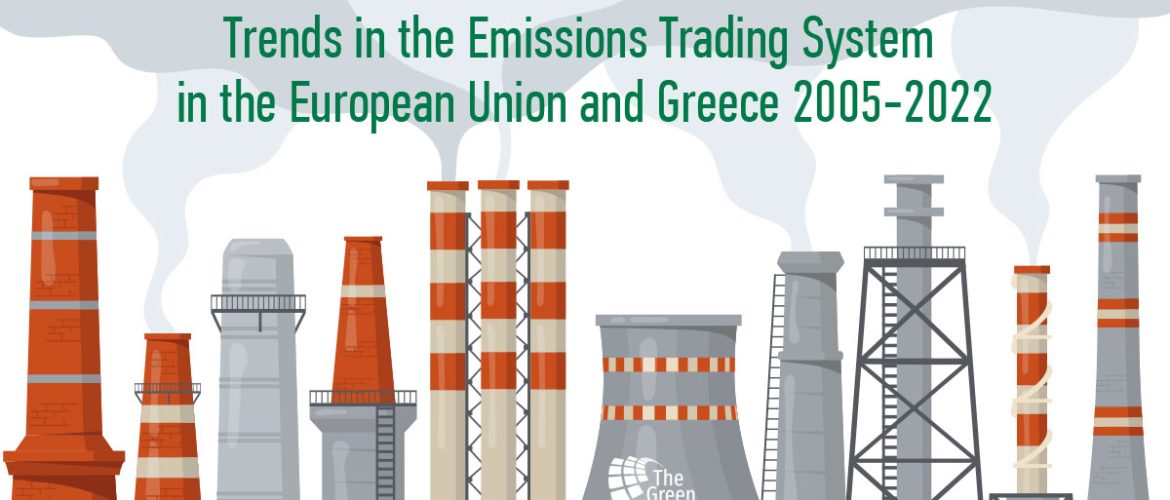Alongside the emergency measures to respond to the crisis, the EU-27 has completed major reforms across its climate legislative files to bring them in line with the Union’s more ambitious targets to reduce net greenhouse gas emissions by at least 55% by 2030 compared to 1990 levels. The most important revision concerned the Emissions Trading System (ETS) directive, the flagship of European climate policy. With the sectors added, the EU ETS will now cover around 75% of the European Union’s greenhouse gas emissions.
Despite the fact that the negotiations on the ETS revision took place in the midst of the unprecedented energy crisis, the European institutions decided to increase the climate ambition compared to the European Commission’s original proposal. They, thus, set a target to reduce emissions from electricity & heat installations and energy-intensive industries by 62% in 2030 compared to 2005 levels.
In this context, Τhe Green Tank in its annual analysis “Trends in the Emissions Trading System” analyses the official data from the European Environment Agency and the Union Registry on the emissions of sectors covered by the EU ETS and shows:
- how have emissions in electricity production, industry and aviation evolved and where are we in relation to the new target of -62% for 2030 in the EU-27 and Greece,
- how do emissions in 2022 compare with those in 2021, the year the energy crisis started, and with those in 2005, the first year of EU ETS operation,
- who were the top polluters in Greece and which sector has polluted the most since 2005 to date.
According to the findings of the analysis:
- Greece achieved a 57.1% decrease in emissions from all installations in the sectors of electricity and heat production and energy-intensive industry; this performance puts Greece in the 6th place in the EU-27 ranking, 12 places above the EU-27 average (-37.9%). Despite the energy crisis, in absolute terms 2022 emissions were lower than in 2021 (34 million tons)
- The largest contribution to the country’s progress towards cutting EU ETS emissions was made by the electricity and heat production sector with reduced emissions by 63.9% compared to 2005. This performance was overwhelmingly driven by the decline of electricity production from lignite-fired power plants; throughout the 17 years of EU ETS operation, the latter have cut their emissions by 80.3%.
- Specifically, in 2022, the emissions of the sector decreased by 5.3% compared to 2021, due to the substitution of fossil fuels -and in particular fossil gas- by RES. As a result, the sector’s emissions reached an all-time low of 19.3 million tons, which is, nonetheless, a long way from the target set by the NECP for 2030 (7 million tons).
- The industrial sector emitted a total of 12.5 million tons of CO2 equivalent in 2022, which represents a 30.5% cut compared to 2005, once again exceeding the corresponding decrease in the EU-27 (-10%). Compared to 2021, industrial emissions in Greece were reduced by 3.3%; this decrease fails to match the corresponding EU-27 average (-6.4%).
- With 1.1 million tons emitted in 2022, the aviation sector in Greece showed a 54.7% increase compared to 2013. In 2022, just two years after the 2020 minimum, sector emissions surged by 129.1%, approaching 2019 pre-pandemic levels; this increase is significantly greater than that recorded in the EU-27 (+95.3%).
- Despite lignite production being phased out, lignite plants still have the highest emissions among all EU ETS subsectors. The top five in the ranking of the 10 biggest polluters for 2022 were, in order, the lignite plant of Agios Dimitrios –historically holding the first place – three refineries and Megalopolis 4.
“Despite Greece’s great progress in reducing greenhouse gas emissions from installations covered by the EU Εmissions Τrading System, performance in 2022 is still far from the national climate targets for 2030. A more proactive national energy and industrial policy is therefore required to reduce the carbon footprint of the two key sectors This needs to be reflected in both the NECP under review and the respective sectoral carbon budgets under the National Climate Law,” said Nikos Mantzaris, energy and climate policy analyst and co-founder, The Green Tank.
The analysis by The Green Tank titled “Trends in the Emissions Trading System 2005-2022” is available here.



















































































































































































































































































































